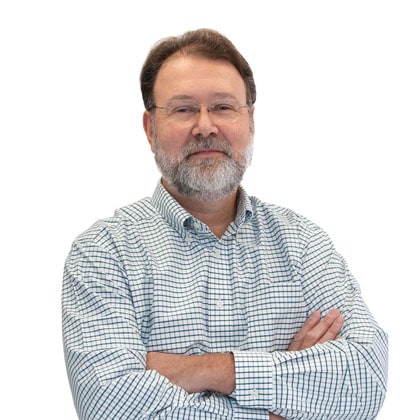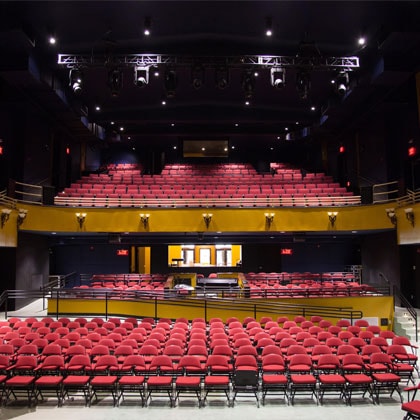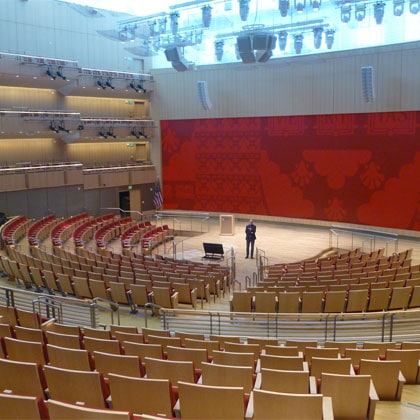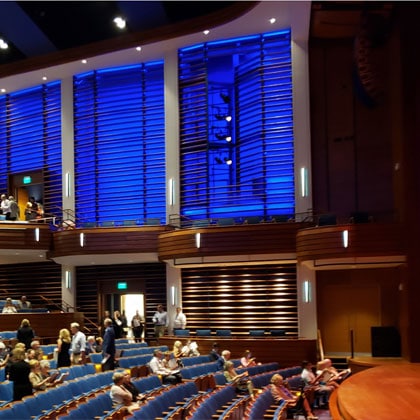
As the lead performance lighting and infrastructure designer for Theatre Projects, Steven Rust develops lighting system specifications for a broad range of venues and spaces, from theaters and convention centers to visitor attractions and retail spaces. Before becoming a theater consultant, he worked as a lighting designer for dance, regional theatre, and on Broadway. Today he is a leader in LED lighting technology - promoting its adoption, and advising on the elements required to incorporate the technology into performing arts spaces of all kinds.
How did you first become involved with performance technology?
I was in a rock band in High School. We wanted to look like Led Zeppelin and realized we needed stage lights and fog machines. I found a few equipment catalogues which got me hooked. I discovered theatre lighting design in college and never looked back except for a brief time out for a degree in Economics.
What was your route to becoming a performance technology consultant?
My first professional job out of College was at Goodspeed Opera House in East Haddam, CT. This small, terrific theatre had a Light Palette console. That was the console to know at the time and that knowledge helped me for years, both as a designer in New York and on the road.
I worked with Columbia Artists Management touring companies as a Stage Manager and Lighting Director for a number of years. It showed me that choices in the design of a building and its systems can make the difference of efficiently utilized labor and a successful show. I looked into the architectural world of theatre design, took some CAD classes, and started my career as a consultant.
How long have you been doing what you do?
I have been working in stage lighting design for over forty years, and in system consulting for about twenty years.
If you hadn’t become a consultant, what do you think you’d be doing instead?
I’d be in a Led Zeppelin cover band.
If someone asks you what you do for a living, how do you describe it?
I design lighting systems and infrastructure for performing arts and entertainment facilities.
Can you outline the variety of the projects you undertake?
Theatre Projects works on all types of gathering and storytelling spaces from theaters, museums, stadiums, and convention centers to brand and retail spaces, commercial venues, and hospitality spaces. In the last few years, the projects I have worked on have ranged from a small local Rock & Roll house in Norwalk, Connecticut to a three-venue performing arts center in Mumbai.
What do you most enjoy about the process of your work?
Finding creative and collaborative solutions no one has tried before.
Front of House lighting positions can be a particularly complex area of auditorium design. I enjoy finding new ways to combine the elements from the architects, acousticians, and engineers with the requirements for stage lighting. My role is to provide knowledge of lighting angles, power distribution, and safety requirements to mesh with the architect’s vision of the space.
At the Jay & Susie Gogue Performing Arts Center at Auburn University, the box boom lighting position is a collaboration representing elements of architecture, architectural lighting, and theatre design. Students can access the lights from two platforms which makes lighting installation and focus safe and free from ladders. The box boom is folded into the wall which, mixed with the silhouetted slats, becomes a near-sculptural object. Theatre Projects worked closely with Wilson Butler Architects and Newcomb & Boyd Lighting Design to create this solution to a challenging requirement in a theatrical space.
What are the most challenging aspects of your work?
Matching expectations and costs. Early in the design process we meet with people of various departments and constituents for the proposed facility. Each group voices their wants and aspirations, but the budget may have already been set for the project. Our goal is to distill the various points of view down to the essence of the requests to find solutions in keeping with the budget.
One example is a recent renovation of a local theatre to a popular music venue. Fixed seats on a sloped floor would have been costly and would set the space for a given style of performance. We recommended a tiered flat floor for the auditorium. This solution was a less expensive alternative which provided greater flexibility for the venue.
What would you say are the key elements of a successful project?
A happy owner, design team, and a little profit. Performance venues are attractive buildings. Theatre designers enjoy working on the blend of aesthetics and technology, owners want a space which meets the needs of their mission, and architects want to find the right mix of design and practicality in a complex space. Ultimately, however, each project is a business venture. Close attention must be paid to the construction costs throughout the process, otherwise choices will be forced upon the owner. This pressure on costs must be weighed with the overall design vision. A successful project will have a well-defined process to determine the balance between cost and design.
What are the key skills or attributes that you require to do your job well?
An in-house team with wide knowledge of architectural drafting standards and stage technology background.
What are the most common misconceptions that you encounter among clients?
One common misconception is that we only work on theatres. We bring the technology and design aesthetics from the production world to all types of spaces. We currently have a number of retail, commercial, and event space projects on the boards.
Which piece of advice do you give to clients most often?
For new construction projects, we often recommend that the design team organize tours of similar spaces. Seeing how a space functions promotes conversation and questions.
What is the most frustrating aspect of your job?
Keeping adequate backstage storage in the project. Storage rooms are often the first spaces cut from a project during budget reviews.
Can you tell us something about being a consultant that most people don’t realize?
Most of us would probably rather not be called “consultants”. We’re designers and planners who come from various areas of the performing arts, event management, and architecture.
Which types of projects do you find the most rewarding?
It varies from time-to-time depending on a number of factors. Renovation projects are on the top of my list at the moment. Fitting new technology in to historic finishes is a challenging and wonderful part of our work. We’re working on a Broadway theatre project at the moment which involves adding commercial space for retail as well as the renovation of the existing auditorium and support spaces. The theatre interior is landmarked, so we’re taking a very careful approach across all elements of the new systems. When complete, the space will remain a 1920s theatre, equipped with the latest in fiber optic lighting control networks.
Which of your projects have you found most satisfying, and why?
Silver Hall for Case Western University, Klarman Hall and HBS Studios for Harvard Business School, Wall Street Theatre in Norwalk, CT, and Jio World Centre in Mumbai. These projects all faced significant challenges and required creative solutions to meet the client’s objectives.
How do you keep yourself appraised of new technology and potential solutions?
Reading trade magazines, attending trade shows, and asking manufacturers to share R&D efforts.
How has clients’ awareness of LED lighting technology changed in recent years?
LEDs are now ubiquitous. All house lighting and work lighting is LED. Some clients want the ability to use incandescent stage lights, but that list grows shorter with each improvement in the technology. The quality of LED lighting performance can vary significantly and not simply based on price: higher-priced fixtures do not always yield better results. We recommend and organize tests for house lights and live comparisons for stage lights.
What are the biggest changes you’ve witnessed in equipment & system specifications in recent years?
The decline of the dimmer rack and the switch to a more rational electrical distribution. Just a few years ago we would specify hundreds of circuits for even very small theatres. We can now specify about one-third the number of circuits utilizing LED or distributed dimming models.
How important is it for you to have a close working relationship with the equipment manufacturer’s representatives?
Very important. We rely on the manufacturer’s representatives from the design phases of the project through construction and owner training. This relationship is critical for a successful installation and a satisfied client.
Solutions-wise, what is missing in the marketplace? What would you most like to see from manufacturers?
Graphic controls for automated lighting. PoE architectural lighting systems. Convection cooled stage lighting.



